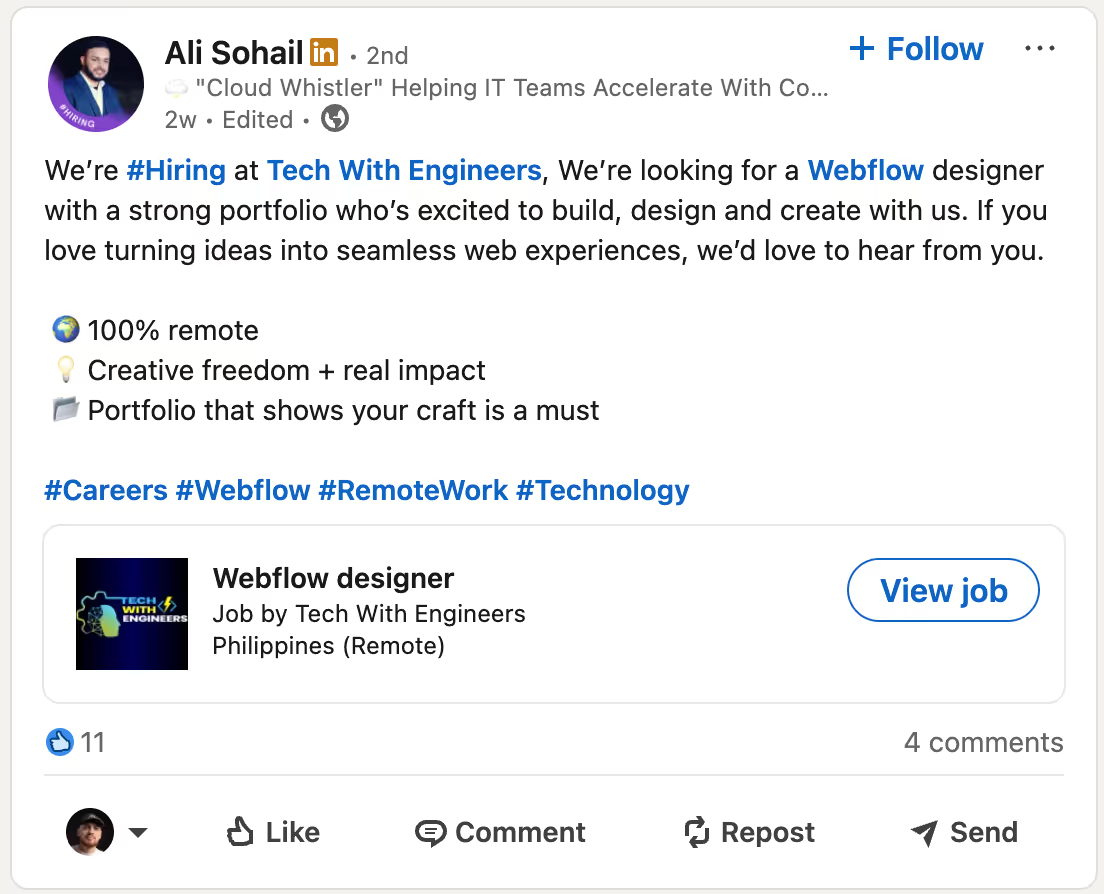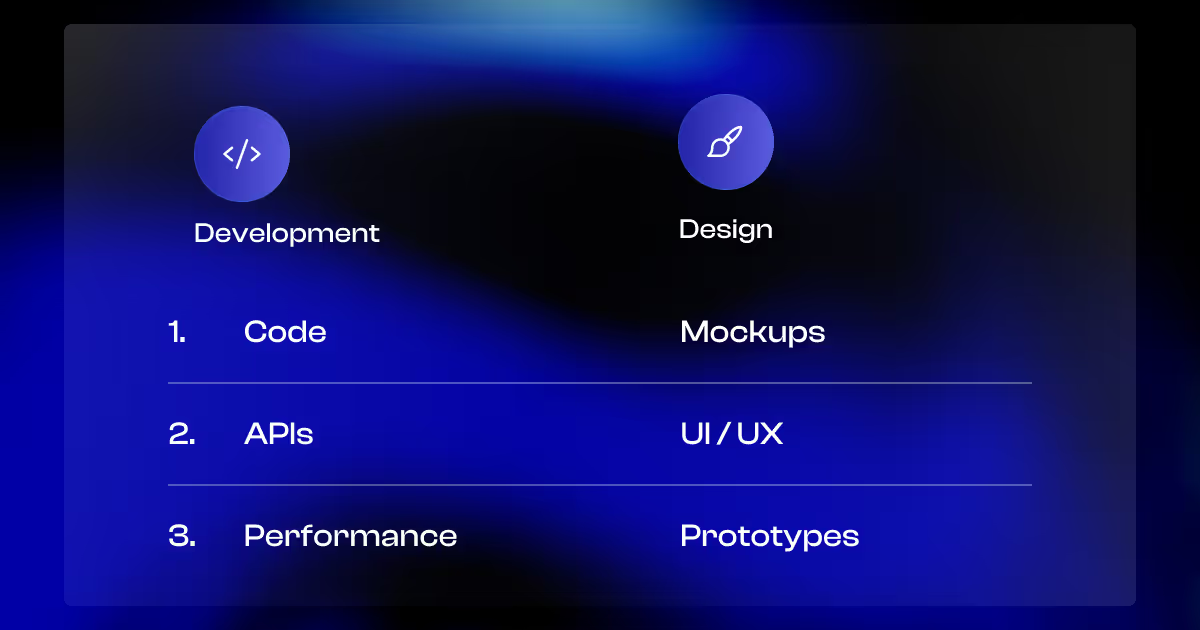The terms "web design" and "web development" get used interchangeably. They shouldn't be.
They represent different skill sets, different deliverables, and different costs. Confusing them leads to misaligned expectations, blown budgets, and projects that stall halfway through.
This confusion shows up everywhere. Here's a real LinkedIn job post searching for a "Webflow designer" when the role actually requires both a web designer (for the visual work) and a Webflow developer (to build it):

If you're planning a website project, this guide will help you understand what each role actually does and which expertise you need.
What is Web Design?
Web design is the discipline responsible for how a website looks and feels.
It covers layout, color schemes, typography, imagery, and navigation. But it's not just about aesthetics. Effective design also determines how content is organized, how users flow through pages, and how the interface guides visitors toward action.
A designer's work directly impacts whether visitors stay, trust your brand, and convert.
What Web Designers Do
Designers translate business goals into visual solutions. A typical workflow includes:
- Discovery sessions to understand your brand and audience
- Wireframes that map out page structure
- High-fidelity mockups showing exactly how the site will look
- Color palettes, typography, and imagery selection
- Interactive prototypes to test user flows
- Collaboration with developers to ensure designs are buildable
The goal: an interface that looks professional, feels intuitive, and moves users toward conversion.
We wrote a detailed breakdown of our website design process to give you a better overview.
Designer’s Tools of the Trade
Many designers also know basic HTML and CSS. Some use no-code platforms like Webflow to build simpler sites themselves. However, for more complex requirements, it’s a good idea to partner with a Webflow development agency to implement your designs and ensure everything works properly.
But when projects require custom functionality, design alone isn't enough.
What is Web Development?
Web development is the engineering discipline that makes websites actually work.
Developers write the code that renders pages, processes user interactions, stores data, and handles security. Without development, even the best design remains a static image.
Front-End vs Back-End
Development splits into two specializations:
Front-End Development is the client side. Everything that runs in the browser.
Front-end developers translate mockups into code using HTML, CSS, and JavaScript. They handle cross-browser compatibility, responsive behavior, animations, and load performance.
Back-End Development is the server side. Everything users don't see.
Back-end developers build servers, databases, APIs, and application logic. They handle user authentication, payment processing, data storage, and security.
Full-Stack Developers work across both. They can build complete applications, though they may not have the same depth as specialists.
Developer’s Tools of the Trade
Developers also work with CMS platforms (WordPress, Webflow) and handle deployment, version control, and performance optimization.
The technical depth required is why development typically costs more than design.

Key Differences at a Glance
The short version: Design is form. Development is a function.
Design vs Development: Timeline Expectations
Beyond skills and tools, these disciplines operate on different timelines:
Design Iteration is Fast
Designers can produce multiple mockup variations in hours or days. Revisions happen quickly because you're working with visual tools, not code. Testing different layouts, colors, or navigation structures is relatively low-cost.
This speed makes design ideal for exploration and refinement. You can try a few homepage concepts in a week.
Development Takes Longer
Writing, testing, and debugging code is slower. A visual change that takes a designer 10 minutes might take a developer an hour to implement properly across all browsers and devices. Development also includes invisible work: setting up environments, managing dependencies, writing tests, handling edge cases, and ensuring security. This doesn't mean developers are slow. It means code has more constraints than pixels.
Why This Matters for Planning
If you expect to iterate on functionality the way you iterate on design, your timeline will explode. The smart approach:
- Finalize designs before development starts
- Batch feedback to avoid constant back-and-forth
- Reserve development time for building, not exploring
- Plan for quality assurance and testing phases
Projects that respect these different speeds finish on time. Projects that don't, don't.
What About No-Code?
Platforms like Webflow, Squarespace, and WordPress themes have changed the market significantly. Designers can now publish functional sites without writing code, and many "developer" tasks happen through visual interfaces.
When No-Code Works:
- Marketing sites with standard pages (home, about, contact, blog)
- Portfolio or showcase sites
- Basic e-commerce with standard checkout flows
- Landing pages with forms and simple integrations
- Sites where pre-built templates meet 70% of your needs
When You Still Need a Developer:
- Custom functionality that doesn't exist in the platform
- Complex user authentication or member portals
- Advanced e-commerce (custom checkout, inventory management, multi-vendor)
- Third-party API integrations beyond standard plugins
- Performance optimization for high-traffic sites
- Custom animations or interactions beyond platform capabilities
The bottom line: No-code expands what designers can deliver independently, but it doesn't replace developers for complex requirements.

When to Hire a Web Designer
Bring on a designer when:
- You need a new visual identity or brand refresh
- Your current site looks outdated
- You want to improve user experience and conversion paths
- You're starting a project and need to define how it should look
- You have developers but lack design direction
A designer creates the visual blueprint. For simple projects, they may also implement it using no-code tools.
When to Hire a Web Developer
Bring on a developer when:
- You need custom functionality (booking systems, calculators, portals)
- You're building e-commerce with complex inventory or payments
- You need integrations with third-party systems (CRMs, APIs, databases)
- Your site has performance problems requiring code-level fixes
- You're migrating platforms or fixing technical debt
A developer builds the functionality. They typically work from existing designs or established design systems.
When to Hire Both (or an Agency)
Most serious website projects need both disciplines:
- Launching a new site from scratch
- Building something with custom design and custom functionality
- Projects with conversion goals requiring strategic design and robust implementation
- Teams without internal expertise in either area
No matter if you hire a B2B web design agency, or a development one, they bundle both roles in a single offer. It’s valuable as it reduces the needed managerial overhead and keeps design and development aligned throughout the project.
Setting Expectations with Freelancers
If you hire a freelance designer, clarify what you're getting:
- Design only: Mockups and assets for a developer to build
- Design + implementation: A finished site using no-code tools
- Design + dev partnership: They'll bring in a developer for the build
The same applies to developers. Some handle basic design. Others expect completed mockups.
Misaligned expectations cause most project conflicts. Ask directly before signing anything.
Why Most Projects Need Both
Here's what happens when you have only one:
Design without development: Beautiful mockups that never go live, or a no-code site that hits platform limitations and can't grow with your business.
Development without design: A functional site that looks like it was built in 2010, driving visitors away before they experience how well it works.
The projects that convert balance both disciplines. Visual hierarchy guides users toward action. Intuitive navigation reduces friction. Fast load times prevent abandonment. Secure transactions build confidence.
You can't achieve this with design or development alone. You need both working together from the start.

Avoiding Common Pitfalls (and How to Prevent Them)
Understanding the difference between design and development isn't just theory. It directly impacts your timeline, budget, and project success.
Here are the mistakes we see most often:
"Why isn't my site live yet?"
This happens when someone hires a designer expecting a finished website.
The mockups look great. But mockups aren't code. The project stalls while everyone figures out who's actually building the thing.
How to prevent it: Clarify upfront whether you're paying for design only or design plus build. Your proposal should separate these as distinct phases.
"This doesn't look like the mockup."
Developers working without clear specs, interaction notes, or responsive guidelines ship something that feels "off."
Small details get lost. The spacing looks wrong. The final product doesn't match what was approved.
How to prevent it: Require a proper handoff before development starts. That means finalized specs, exported assets, interaction notes, and layouts for mobile and desktop.
"Why does this cost so much?"
Design and development require different skills, tools, and time.
When they're bundled into a single "website" line item, the price feels arbitrary. Sticker shock is almost guaranteed.
How to prevent it: Break your project into separate line items. You'll understand what you're paying for, and adjusting scope becomes easier.
When you're clear on where design ends and development begins, you avoid most surprises: delayed launches, mismatched expectations, and budgets that spiral.
The Bottom Line
Web design determines how your site looks and how users experience it.
Web development determines how your site works and how reliably it performs.
Professional websites require both.
Whether you hire freelancers, build an internal team, or partner with an agency, understanding this distinction helps you plan effectively, communicate clearly, and launch sites that actually achieve your goals.
Frequently Asked Questions
Can one person do both web design and web development?
Yes, but it's rare. These professionals are sometimes called "unicorns" because the skill sets are so different. For simple projects, a generalist using no-code tools can handle both. For complex sites, specialists working together consistently produce better results.
Do I need a web developer if I'm using Webflow or Squarespace?
Not always. A designer comfortable with these platforms can build and launch a functional site. But if you need custom functionality, third-party integrations, or performance optimization beyond what the platform offers, you'll need a developer.
Which costs more: web design or web development?
Development typically costs more, but rates vary widely based on experience, location, and specialization. Junior designers might charge $25 - $40/hour, while senior designers command $60 - $100+. Developers generally start higher ($35 - $60 for juniors) and senior or specialized developers can charge $80 - $150+. Agency rates are typically higher than freelancers but include project management and coordination.
Should I hire an agency or separate freelancers?
Depends on your project complexity and how much coordination you want to manage. Freelancers can be cost-effective for clearly scoped projects. Agencies cost more but handle coordination internally and ensure design and development stay aligned. For business-critical sites, the agency premium often pays for itself in fewer headaches.





